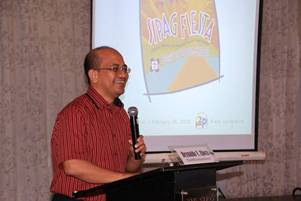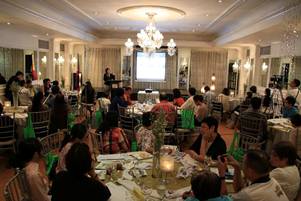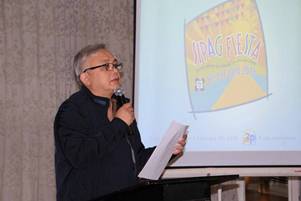 The Philippine Council for Agriculture Aquatic and Natural Resources Research and Development (PCAARRD) and the Science and Technology Information Institute (STII), both of the Department of Science and Technology, gathered more than 60 media representatives, who are engaged in agriculture-aquatic concerns, for the promotion of SIPAG FIESTA.
The Philippine Council for Agriculture Aquatic and Natural Resources Research and Development (PCAARRD) and the Science and Technology Information Institute (STII), both of the Department of Science and Technology, gathered more than 60 media representatives, who are engaged in agriculture-aquatic concerns, for the promotion of SIPAG FIESTA.
To be held on March 2 to 4 at the PCAARRD complex, SIPAG FIESTA will showcase the best of the technologies generated by the country’s research and development institutions on agri-aqua concerns.
Some of the technologies to be featured include carrageenan plant growth regulator (CPGR); Coconut somatic embryogenesis; Swine genomics; Shrimp biofloc technology; Smarter agriculture; Improved Lakatan varieties resistant to Banana Bunchy Top Virus (BBTV) and Cavendish resistant to Fusarium Wilt; Rice mechanization; and Asexual reproduction of corals for transplantation.
Five of these technologies were presented during a media gathering held at Manansala Hall of the Sulo Riviera Hotel in Quezon City on February 26.
CPGR, which is extracted from seaweeds using gamma radiation, when applied at low concentrations in rice, enhances its yield by 15–30% in multi-location trials conducted in Bulacan, Nueva Ecija, Laguna, and Iloilo.
 Coconut somatic embryogenesis or CSet, allows the mass production of more pest and disease-resistant coconuts of superior quality from one to 1,000 plantlets per plumule by using explants from high yielding tall and dwarf coconut varieties.
Coconut somatic embryogenesis or CSet, allows the mass production of more pest and disease-resistant coconuts of superior quality from one to 1,000 plantlets per plumule by using explants from high yielding tall and dwarf coconut varieties.
Swine genomics has increased pigs produced per sow per year by 4.6 piglets, which is equivalent to an additional 460 kilograms of hog liveweight or a 25―30% increase in pork production without increasing the breeder pig population. This was made possible by the development of sixteen gene marker protocols associated to high litter size, fast growth rate, meat qualities, and screening of genetic defects and disease resistance.
Smarter Agriculture technology provides farmers and decision makers with a decision support system in dealing with the effects of climate change in the agricultural sector using advances in S&T. As of 2015, the program has already produced outputs in terms of technologies, systems, data products, and networks or linkages.
 Lastly, shrimp biofloc technology reduces shrimp’s reliance on protein from feeds; improves shrimp’s nutrition as the technology enhances feed conversion ratio, resulting in larger shrimps; and enhances shrimp’s immune system. The technology uses a microbial mat composed of aggregates of bacteria, algae, protozoa, detritus, and dead organic particles that help control the natural microbial activity in aquaculture ponds.
Lastly, shrimp biofloc technology reduces shrimp’s reliance on protein from feeds; improves shrimp’s nutrition as the technology enhances feed conversion ratio, resulting in larger shrimps; and enhances shrimp’s immune system. The technology uses a microbial mat composed of aggregates of bacteria, algae, protozoa, detritus, and dead organic particles that help control the natural microbial activity in aquaculture ponds.
“We at DOST value media’s huge help in disseminating these technologies. Surely, you have always been instrumental in relaying the good news. More importantly, we continue to enrol your assistance in changing mind sets and in creating a culture of science in the larger sectors of society,” said DOST Secretary Mario G. Montejo in his message read by Assistant Secretary Raymund E. Liboro.
Tackled during the event in response to media’s queries were the safety of CPGR; status of biotechnology researches in relation to the Department of Agriculture’s Administrative Order No. 8; technology on having more gilts in a sow’s litter through genetic markers; farmers’ response to Smarter Agriculture; and the status of the country’s swine experts; among other issues.
SIPAG reflects the vision and direction of S&T as laid down in the Council’s Strategic Industry S&T Program for Agri-Aqua Growth (SIPAG). It also embodies the Council’s commitment to Outcome One of DOST-PCAARRD in a bid to ensure that the fruits of R&D activities for the said sectors will be a blessing for every Juan, in keeping with the President’s social contract.
Outcome One, the foremost of DOST’s eight major Outcomes, seeks to provide the agri-aqua sectors with science-based know-how and tools that will enable the said sectors to raise productivity to world-class standards.
Meanwhile, DOST-PCAARRD’s Farms and Industry Encounters through the Science and Technology Agenda or FIESTA, one of the Council’s technology diffusion strategies, typifies a fiesta atmosphere created to enhance agri-aqua technology transfer and commercialization.
